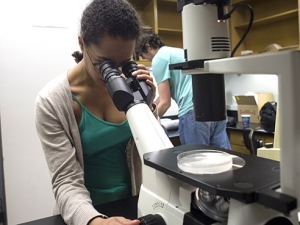 An enzyme closely associated with genetic forms of Parkinson’s disease appears to play a larger role in its progression than previously thought, say UAB investigators. The new research offers encouraging evidence that drugs to block this enzyme, known as leucine-rich repeat kinase 2 or LRRK2, could slow — or even prevent — Parkinson’s from developing.
An enzyme closely associated with genetic forms of Parkinson’s disease appears to play a larger role in its progression than previously thought, say UAB investigators. The new research offers encouraging evidence that drugs to block this enzyme, known as leucine-rich repeat kinase 2 or LRRK2, could slow — or even prevent — Parkinson’s from developing.
In the study, published online in the Proceedings of the National Academy of Sciences June 4, UAB researchers eliminated the gene for LRRK2 (pronounced “lark two”) in rats and combined these animals with genetic models of Parkinson’s.
“We found that this offered very good protection from over-expression of a protein — alpha synuclein — that is linked to Parkinson’s disease,” said Andrew West, Ph.D., lead author on the paper and the John A. and Ruth R. Jurenko Endowed Professor in Neurology at UAB.
The genetic model used in the UAB study more closely mimics Parkinson’s disease than do other, more frequently used models, which suggests that inhibiting LRRK2 in humans could help more than those with the less-common genetic forms.
“The pool of Parkinson’s patients who might benefit from LRRK2 drugs may be bigger than we originally thought,” West said.
West’s lab is working closely with Birmingham-based Southern Research Institute through the Alabama Drug Discovery Alliance to rapidly develop LRRK2 inhibitors. He hopes to reach human testing as early as 2015.
Parkinson’s disease affects more than a million Americans. Tremors, stiff muscles and slow movement are the most common symptoms of the disease. These symptoms are caused by a massive loss of cells in the substantia nigra, a brain region that helps control movement. The dying cells are filled with clumps of alpha-synuclein, making it the chief suspect in Parkinson’s disease.
Refining the target
The trouble is that researchers have not found a way to control alpha-synuclein levels directly.
“It’s a normal protein — actually one of the most highly abundant proteins in the brain — so it isn’t easy to figure out how to block its progression into aggregates that spread through the brain,” West said.
That is why Parkinson’s researchers are so excited about LRRK2. In 2006, West demonstrated that all known mutations in LRRK2 increase LRRK2 activity. Other studies showed that LRRK2 is biochemically linked with alpha-synuclein in several ways.
| Andrew West’s lab is working closely with Birmingham-based Southern Research Institute through the Alabama Drug Discovery Alliance to rapidly develop LRRK2 inhibitors. He hopes to reach human testing as early as 2015. |
Since those discoveries in the rats, the idea has been that developing drugs to reduce LRRK2 activity should provide protection against damage caused by alpha-synuclein, according to West.
Genetic forms of Parkinson’s that have highlighted LRRK2 involvement in disease are widespread in some populations, including those of Ashkenazi Jewish and North African Berber descent, where inherited Parkinson’s accounts for up to 40 percent of cases.
“But it drops dramatically depending on your ethnic background,” West said. “If you’re from a European, Caucasian population, it’s more on the order of 2 to 3 percent. This may be important in initial first-in-man studies in deciding who should first get LRRK2 drugs.”
Advancing to human trials
Any treatment advance would be welcome in Parkinson’s, which West says has not seen a real breakthrough drug since L-dopa was developed 50 years ago.
“Together with Southern Research Institute, we have a very strong drug pipeline, and we hope to be in first-in-man studies as early as next year,” West said. “But while that work is ongoing, we need to ask a bigger question: What happens if you simply remove all LRRK2 activity? Modern approaches allow us to approximate what a perfect drug would do in rats and mice.”
The results, captured in the PNAS paper, emphasize the importance of LRRK2 and the need for further study, which West is pursuing.
“We think LRRK2 is plugging into Parkinson’s disease in more than one way,” West explained. “It is making the disease more likely to happen and making it progress faster when it does happen. So we think knocking out LRRK2 will do the opposite — slow the disease or make it much less likely to develop.”
Even slowing the disease marginally could have a tremendous effect on patients with Parkinson’s disease, West notes. Drugs like L-dopa are effective at controlling symptoms and making life manageable for patients; but they eventually stop working, and side effects inevitably become as burdensome as the disease itself, West says.
LRRK2 inhibitors could greatly extend the useful window for L-dopa treatment.
“Whereas L-dopa may be effective for 10 years currently, if LRRK2 inhibitors slowed disease progression, we could dramatically extend the effectiveness of existing drugs to 20, 30 or 40 years — basically the rest of the patient’s life.”







































